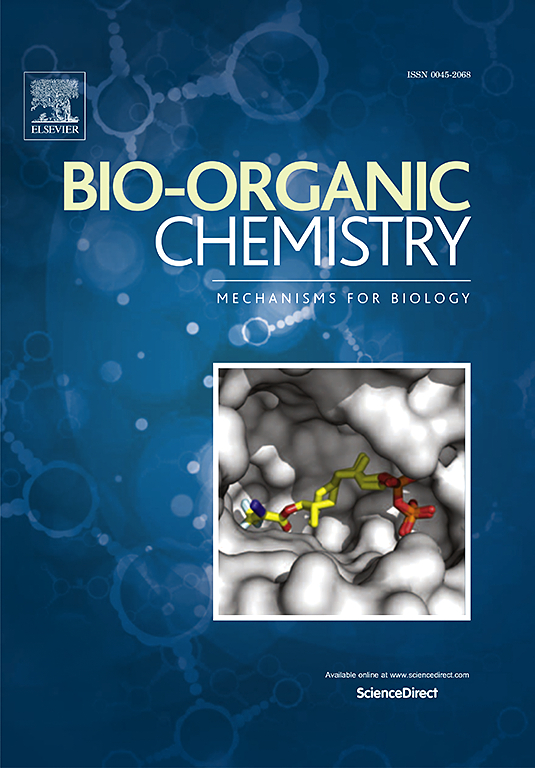新型硫脲衍生物作为前列腺特异性膜抗原小分子抑制剂的设计、合成和生物学评价。
IF 4.5
2区 医学
Q1 BIOCHEMISTRY & MOLECULAR BIOLOGY
引用次数: 0
摘要
前列腺癌(PCa)已成为男性癌症相关死亡的第二大原因。利用靶向性放射性药物对前列腺癌细胞进行分子成像,有望准确地确定原发疾病的分期,检测局部和转移性肿瘤,并有助于预测疾病的进展。谷氨酸脲异质二聚体作为高亲和小分子被广泛应用于前列腺特异性膜抗原(PSMA)的结合口袋中。然而,分子对接和QSAR模型的广泛研究预测,谷氨酸脲异质二聚体分子中的氧原子与硫的生物等异质取代将产生一个新的纳摩尔范围内的高亲和力配体库,以靶向PSMA。基于这些预测,一类新的谷氨酸硫脲衍生物被设计和开发用于与PSMA结合。本文描述了一种新的方法,在硅引导下选择和化学合成谷氨酸硫脲小分子PSMA抑制剂。其中一种高亲和力的谷氨酸硫脲配体通过肽间隔剂使用螯合片段进一步与放射性同位素如99mTechnetium螯合,并靶向PSMA+ LNCaP和22Rv1细胞。新合成的99mtc生物偶联物在体外研究中显示出选择性靶向PSMA+癌症的纳摩尔亲和力。总的来说,这些psma特异性小分子放射显像剂在监测前列腺癌患者的疾病预后和治疗选择方面具有重要的前景。本文章由计算机程序翻译,如有差异,请以英文原文为准。

Design, synthesis, and biological evaluation of novel thiourea derivatives as small molecule inhibitors for prostate specific membrane antigen
Prostate cancer (PCa) has emerged to be the second leading cause of cancer-related deaths in men. Molecular imaging of PCa using targeted radiopharmaceuticals specifically to PCa cells promises accurate staging of primary disease, detection of localized and metastasized tumours, and helps predict the progression of the disease. Glutamate urea heterodimers have been popularly used as high-affinity small molecules in the binding pockets of popular and well-characterized PCa biomarker, prostate specific membrane antigen (PSMA). However, extensive studies in molecular docking and the QSAR model have predicted that bioisotere substitution of an oxygen atom with sulfur in the glutamate urea heterodimer molecules would yield a new library of high-affinity ligands in the nanomolar range to target PSMA. Based on these predictions, a new class of glutamate thiourea derivatives has been designed and developed for binding with PSMA. The in silico guided selection and chemical synthesis of glutamate thiourea small molecule PSMA inhibitors by a new methodology is described in this report. One of the high-affinity glutamate thiourea ligands was further chelated to radioisotopes such as 99mTechnetium using a chelating moiety via a peptide spacer and targeted to PSMA+ LNCaP and 22Rv1 cells. The newly synthesized 99mTc-bioconjugate has shown nanomolar affinity to selectively target PSMA+ cancers during in vitro studies. Collectively, these PSMA-specific small molecule radio-imaging agents show significant promise in monitoring disease prognosis and treatment selection of PCa patients.
求助全文
通过发布文献求助,成功后即可免费获取论文全文。
去求助
来源期刊

Bioorganic Chemistry
生物-生化与分子生物学
CiteScore
9.70
自引率
3.90%
发文量
679
审稿时长
31 days
期刊介绍:
Bioorganic Chemistry publishes research that addresses biological questions at the molecular level, using organic chemistry and principles of physical organic chemistry. The scope of the journal covers a range of topics at the organic chemistry-biology interface, including: enzyme catalysis, biotransformation and enzyme inhibition; nucleic acids chemistry; medicinal chemistry; natural product chemistry, natural product synthesis and natural product biosynthesis; antimicrobial agents; lipid and peptide chemistry; biophysical chemistry; biological probes; bio-orthogonal chemistry and biomimetic chemistry.
For manuscripts dealing with synthetic bioactive compounds, the Journal requires that the molecular target of the compounds described must be known, and must be demonstrated experimentally in the manuscript. For studies involving natural products, if the molecular target is unknown, some data beyond simple cell-based toxicity studies to provide insight into the mechanism of action is required. Studies supported by molecular docking are welcome, but must be supported by experimental data. The Journal does not consider manuscripts that are purely theoretical or computational in nature.
The Journal publishes regular articles, short communications and reviews. Reviews are normally invited by Editors or Editorial Board members. Authors of unsolicited reviews should first contact an Editor or Editorial Board member to determine whether the proposed article is within the scope of the Journal.
 求助内容:
求助内容: 应助结果提醒方式:
应助结果提醒方式:


